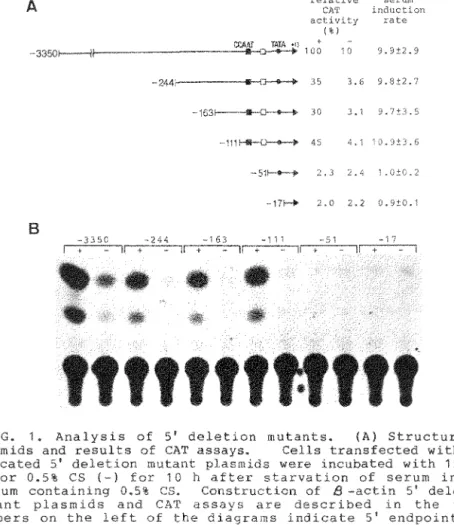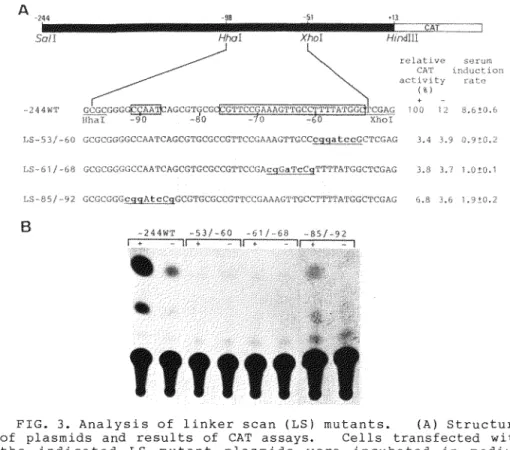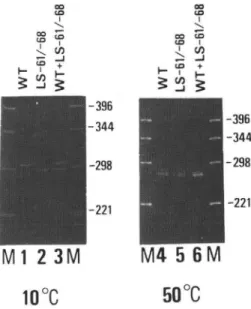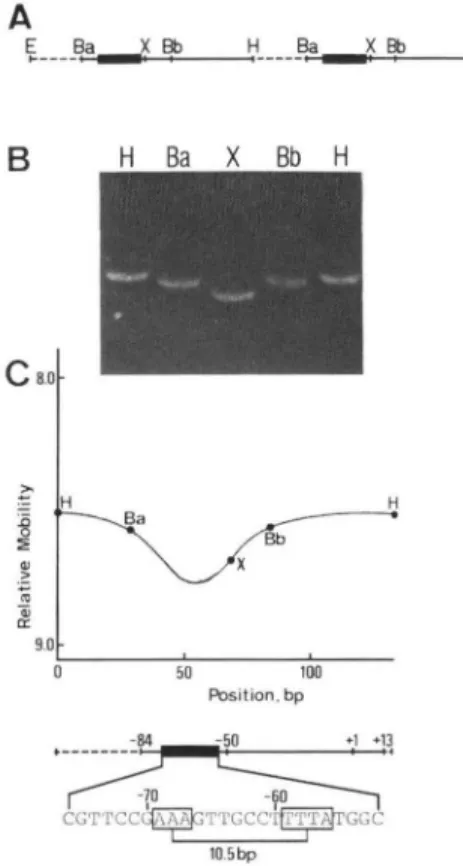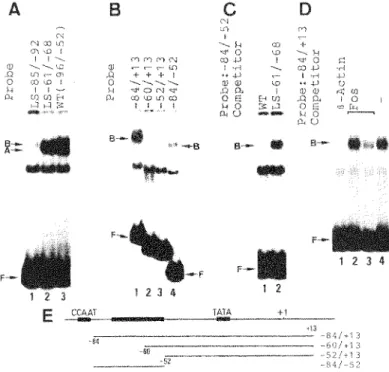Title
action promoter Author(s) 河本, 健
Citation Issue Date
Text Version ETD
URL http://hdl.handle.net/11094/37119 DOI
rights Note
Osaka University Knowledge Archive : OUKA Osaka University Knowledge Archive : OUKA
https://ir.library.osaka-u.ac.jp/repo/ouka/all/
Osaka University
DNA bending and binding factors of the human /3-actin promoter
Takeshi Kawamoto, Kozo Makino1, Satoshi Orita, Atsuo Nakata1 and Takeo Kakunaga
Departments of Oncogene Research and 1Experimental Chemotherapy, Research Institute for Microbial Disease, Osaka University, 3-1 Yamadaoka, Suita, Osaka 565, Japan
Received November 9, 1988: Revised and Accepted December 22, 1988
ABSTRACT
Transcription of the 8 -actin gene is rapidly inducible in response to serum stimulation. To determine the regions responsible for serum inducible and basal level expression, the human 8 -actin promoter was subjected to mutational analysis.
Two distinct elements, the CCAAT homology and the S -actin specific conserved sequences, were found by a chloramphenicol acetyltransferase expression assay and sequence comparisons, and then analyzed for possible functions. Using a DNA bend assay, it was shown that the conserved sequences included the core of a sequence-directed bend of DNA. Gel mobility shift and DNase I protection assays revealed that the conserved sequences and the CCAAT homology were recognized by binding factors in HeLa cell extracts.
INTRODUCTION
Many eucaryotic promoter elements can be separated into basal elements and inducible elements. Basal elements contain the so-called TATA box, usually located 25-30 base pairs (bp) upstream from the cap site, and one or more upstream elements, such as the CCAAT or GGGCGG homologies, located about 20-70 bp further upstream (1, 2, 3). These elements generally function in close proximity to the cap site, but it is not clear whether they play a role in the regulation of transcription. Recent studies in which inducible elements responsive to specific inducers were localized have identified heat shock elements for heat shock genes (4, 5), metal-regulated elements for metallothionein genes (6), glucocorticoid-responsive elements for mouse mammary tumor virus genes (7, 8, 9), and serum response elements for the proto oncogene c-fos (1 Q)_
Transcription of the proto oncogenes c-fos and c-myc, the 8-actin gene, and several other genes of unknown function is
rapidly and transiently activated by serum stimulation (11, 12, 13, 14 ). Stimulation with growth factors in serum is known to result in the progression of the cell from resting state to growing state. The biochemical details, however, of pathways which transmit signals from cytoplasmic membrane receptors to the transcriptional activation of specific genes in the nucleus are not completely understood. To investigate the regulation of B actin gene expression, we have examined the functions of the promoter region using chimeric genes retaining variable mutants fused to the bacterial gene encoding chloramphenicol acetyltransferase (CAT}. Sequences responsive to basal level expression and serum inducible expression resided at -111 to +13 relative to the transcription initiation site (15) of the human 8-actin gene. Two distinct elements required for basal level expression and serum response activity were located in the region between -111 and -51. Gel mobility shift and DNase I protection assays showed that the binding factors recognize these upstream sequences.
Recent studies have demonstrated the existence of sequence- directed bends of Kinetoplast DNA of trypanosomes (16), the replication origins of bacteriophage A (17) and plasmid pT181 (18), and the promoter regions of hisR in Salmonella typhimurium (19) and MF~1 of Saccharomyces cerevisiae (20). Most of these bent DNAs contain spaced {dA/dT) tracts with one run per helical repeat. The importance of the static bend of DNA in the regulation of gene expression and DNA replication has been proposed. In this paper we present evidence that the recognition site of a binding factor contains a sequence-directed bend of DNA.
MATERIALS AND METHODS Construction of plasmids.
To construct chimeric CAT expression plasmids, the plasmid pSV2CAT (21), in which the Acer site was replaced by a SalI site using a SalI linker, was used. The SalI-HindIII fragment of this pSV2CAT derivative was replaced by the fragment containing -3350 to +13 from the cap site of the human 8-actin gene (22) using SalI and HindIII linkers. A series of 5' deletion mutant plasmids were constructed utilizing the Smar site at -244, HapII
site at -111, XhoI site at -51, and S1 nuclease hypersensitive site at -163 and -17 (unpublished data) (see Fig. 1A). For linker scan (LS) mutant construction, a series of BamHI linker scan mutant DNAs from the HhaI site at -98 to the XhoI site at -51 were synthesized ( see Fig. 3A). The
8
-act in HhaI-XhoI fragment of the wild type plasmid containing -244 to +13 (-244WT) was replaced by these mutated synthetic oligonucleotides.The plasmid pAB1, which contains tandem dimers of the B - actin promoter region, was constructed as follows. The BamHI- HindIII fragment containing -84 to +13 from the cap site of the 8-actin gene was cloned into pUC18 to generate pAC1. The EcoRI- HindIII fragment of pAC1 was inserted into the HindIII site of pAC1 using a HindIII linker.
pAB1.
The resulting plasmid was named Cell transfection and CAT assay.
NIH 3T3 cells were passaged in Dulbecco's modified Eagle's medium containing 1 0% calf serum (CS), seeded at approximately 7x10 5 cells per 100-mm-diameter dish, and 16 h later, transfected with 1.75 pmol of CAT plasmid DNA using a calcium phosphate-DNA coprecipitation method (23). Four hours after transfection, the medium was replaced with fresh medium containing 0.5% CS and the cells incubated for a further 35 h (10). For serum stimulation, the cells were then exposed to medium containing 15% cs for 10 h (24).
Cell extracts were prepared by sonication and 300 µg of extract was mixed with 0.6 µCi of
c
14 cJchloramphenicol to a total volume of 200 µl in 250 mM Tris (pH 7.5), 5 mM acetyl coenzyme A.The samples were incubated for 90 min at 37°c and analyzed by silica gel thin-layer chromatography and autoradiography (21).
Quantitation of CAT assays was performed by scintillation
counting of the appropriate areas of the chromatogram. Each CAT assay was performed at least three times to overcome the variability inherent in transfections.
DNA bend assay.
Measurements of DNA bending were performed as described by Wu and Crothers (25). DNAs were digested with the indicated restriction enzymes, ethanol precipitated, and run on a 10%
polyacrylamide gel in TBE buffer.
Mobility shift assay.
HeLa cell extracts were prepared as described by Manley et al. (26). Approximately 0.15 ng of the 32 P-labeled DNA fragments were mixed with 2.5 or 1.0 µg of poly(dI-dC) and 10 µg of protein to a total volume of 10 µl in a solution containing 10 mM Tris (pH 7.5), 50 mM NaCl, 1 mM dithiothreitol, mM EDTA, and 5%
glycerol. The samples were incubated for 10 min at 37°c and loaded onto 5% polyacrylamide gel.
~
1
protection assay.A probe for DNase I footprinting was prepared by 5' end- labeling the DNA fragment at the HindIII site of the 8-actin promoter with [
r -
32 P]ATP and T4 polynucleotide kinase, digesting the DNA with a second restriction enzyme, and isolating the appropriate end-labeled fragment by polyacrylamide gel electrophoresis. Binding reaction and DNase I treatments were carried out as described previously (27).RESULTS
Promoter activities of i'._ deletion mutants.
To define the DNA sequences of the upstream region required for serum inducible expression of the 8 -actin gene, a series of 5' deletion mutants of the human 8-actin promoter region linked to cat gene were constructed and transfected into NIH 3T3 cells.
Ten hours after serum stimulation, the CAT activities of deletion mutants were measured. The values of CAT activity of 51 deletion mutants were normalized relative to the serum-stimulated activity of the parent -3350 plasmid as 100%. Results, as shown in Fig. 1, indicate that CAT activity increased about 10-fold upon serum stimulation in mutants containing at least 111 nucleotides of sequences upstream from the cap site, and that major losses in CAT activity accompanied the deletions -3350 to -244 (from 100% to 35%) and -111 to -51 (from 45% to 2%). The control plasmid pUA10CAT, which contains the simian virus 40 (SV40) early promoter lacking a functional enhancer, showed a low but significant level of CAT activity, but did not exhibit serum response activity (data not shown) (28). These results show that the region between -3350 and -244 is important for basal level activity and the region between -111 and -51 is necessary
A relative CAT induction serum
activity rate
( % ) CCAAJ TATA •ll +
-33501---//1---••-,o---+--+ 100 1 0 9.9±2.9
- 244~
•
35 3.6 9.8±2.7-163~ 30 3 .1 9 .. 7±3.5
-111 ~ 45 4. 1 1 0. 9±: 3. 6
-51-- 2.3 2.4 1. 0±0. 2
-171-+ 2.0 2.? 0. 9:!:0 .1
B -3350 -244 -1 63 -11 i -51 -I 7
+ + + . I
' +
• • • •
.. • • •
FIG. 1. Analysis of 5' deletion mutants. (A) Structure of plasmids and results of CAT assays. Cells transfected with the indicated 5' deletion mutant plasmids were incubated with 15% CS
(+) or 0.5% CS (-) for 10 h after starvation of serum in the medium containing 0.5% CS. Construction of 8 -actin 5' deletion mutant plasmids and CAT assays are described in the text.
Numbers on the left of the diagrams indicate 5' endpoints of deletion mutants. The CAT activity of each plasmid was normalized relative to the serum-stimulated activity of the parent -3350 plasmid. Relative CAT activities in serum- stimulated cells (+) and in serum-starved cells(-), and mean induction rates and standard deviations for each construct are indicated. Closed box, the CCAAT homology; open box, the S - actin specific conserved sequences; closed circle, the TATA box.
(B) Results of representative CAT assays of indicated 5' deletion mutants.
for serum inducible expression. The region from -111 to -51 contains the CCAAT homology and highly conserved sequences among human, rat, and chick 8-actin genes (Fig. 2). The region between -3350 and -244 may contain unknown upstream elements.
-101 CGt;CGC5?-GGGCCAATCAGCQ'.rGCGCf._G_TTC~GAA~GTJ'_~CCTTTTATGGCTCQAGC~.GCCGCGt;c -J7 !lum,tn J3~act in promoter - 99 CGt,,r;ccGGA.GCCJ\A'l'CAGCGCCCGCCGT'I'CCGAA~--TTGCCTTT1'A'l'GGCTC~~AG'!'~GCCGC'i'G'l' - 3(i Rat B-,1ct in pror:io te2 r
JB Chi,;k 13--'l.clin pr·o,noter CCAAT
FIG. 2. Sequence homology among human, rat, and chick 8 -actin promoters. Human, rat, and chick 8-actin gene sequences were described by Nakajima-Iijima et al. (22), Nudel et al. (42), and Kost et al. ( 43 ). Identical nucleotides among human, rat, and chick genes are underlined. Nucleotide positions relative to the cap site and the CCAAT homology are indicated.
Promoter activities of linker scan J1fil_ mutants.
A more detailed analysis of the sequences required for serum-stimulated transcription of the 8-actin promoter was performed by constructing LS mutants located at -92 to -53.
Linker scan mutants of the plasmid -244WT were created as described in Materials and Methods, and the CAT activities of three LS mutants measured (Fig. 3). Linker substitutions involving the CCAAT homology located from -87 to -91 (LS -85/-92) or the 8 -actin specific conserved sequences located from -52 to -76 (LS -53/-60 and LS -61/-68) greatly reduced CAT gene expression and serum response activity. These results suggest that both CCAAT homology and conserved sequences are required for high levels of serum inducible expression, and that the 8-actin specific conserved sequences play a positive functional role in serum response activity of the B-actin promoter, since the mutant within the CCAAT homology region retained a low but significant level of serum response activity.
Bending of 8-actin DNA.
Recently, sequence-directed bends of DNA have been identified in the promoter regions of several genes, and the importance of such bent DNAs in gene expression has been proposed (19, 20, 25, 29). One characteristic of bent DNA molecules is currently thought to be an anomalously slow electrophoretic mobility of the DNA fragment (30). Fig. 4 shows the electrophoretic behavior of DNA fragments of the human 8 -actin promoter region. The 265-bp fragment of the B-actin promoter containing -244 to +13 exhibited slower migration than that of the 298-bp HinfI fragment of pBR322 under an electrophoretic condition of 10°c (lane 1). It has been reported that
-91 -51
Sa/I XhoI
- 244WT GCGCGGG~AGCGTGCG
!lhaf -90 -80
•11 Htndl1I
relative ~erum CAT induction activity r,,1te
( i)
100 12 8.6:t0.6
LS-$ 3 / - 60 GCGCGGGGCCAATCAGCGTGCGCCGTTCCGAAAGTTGC:Ccgga tccGCTCGAG 3. 4 3. 9 0, 9 ! 0. 2
LS--6 i / --68 GC<,CGGGGCC/\ATCAGCGTGCGCCGTTCCGA9..9Ga'rcC9TT1'TATGGCTCGAG 3.8 3. 7 1.0 !Q. 1
LS -8 5 / -92 GCGCGGGcggAtcCgGCGTGCGCCGT'rccGAAAGTTGCCTTTTATGGCTCGAG 6. 8 3. 6 i , 9 !0. 2
B -244WT -53/-60 -61/--68 -85/-92
+ •
• •
'''
FIG. 3. Analysis of linker scan (LS) mutants. (A) Structure of plasmids and results of CAT assays. Cells transfected with the indicated LS mutant plasmids were incubated in medium containing 15% CS(+) or 0.5% CS(-) for 10 h after starvation of serum. Construction of LS mutant plasmids and CAT assays are described in the text. Bold lowercase letters denote changes from the wild type 8 -actin sequences. Numbers (e.g., LS -53/-60) indicate the regi'ons of bases mutated relative to the cap site. The CAT activity of each plasmid was normalized relative to the serum-stimulated activity of the plasmid -244WT.
Relative CAT activities in serum-stimulated cells(+) and in serum-starved cells ( ), mean induction rates, and standard deviations are indicated. Numbers under sequences indicate nucleotide positions from the cap site. The regions of the CCAAT homology and the B -actin specific conserved sequences are boxed. The positions of SalI, HhaI, XhoI, and HindIII sites are shown. Solid box, the 8 -actin promoter; open box, the bacterial cat gene. (B) Results of representative CAT assays of indicated LS mutants.
increasing the temperature of gel electrophoresis causes the gel mobility of the bent DNA to revert to more normal values (30).
In agreement with this, the mobility of the 265-bp 8-actin DNA fragment was close to normal when the gel was run at
so
0c
(Fig.4, lane 4).
00
"'
I00 '-~
"'
I I'- (JJ
;.; ...J +
I- I I-
~ en
~
...J
M 1 2 3M 10 ° C
-396 -344 -298
-221
M4 5 6M 50 ° C
-396 -344 -298
-221
FIG. 4. Electrophoretic analysis of DNA fragments carrying the 8-actin promoter region. 265-bp DNA fragments of wild type and LS -61 /-68 mutant (see Fig. 3A) were subjected to
i
b%polyacrylamide gel electrophoresis which was carried out at 10°c (lanes 1 to 3) or at 50°c (lanes 4 to 6). Samples in each lane are wild type (1 and 4), LS -61/-68 (2 and 5), wild type+ LS -61/-68 (3 and 6), and HinfI digest of pBR322 (M).
To test whether ,S-actin specific conserved sequences are responsible for the anomalous gel mobility, a linker scan mutant (LS -61/-68) was used (see Fig. 3A). When the gel was run at 50°c, this mutant DNA fragment exhibited almost the same migration pattern as the wild type (Fig. 4, lanes 5 and 6). In contrast, mobility of this mutant fragment was faster than that of the wild type DNA fragment when run at 10°c (Fig. 4, lanes 2 and 3). These results suggest that the anomalous migration of the 8-actin promoter region is due to a sequence-induced bending of the region containing -68 to -61. To investigate this sequence-induced bending, we constructed a head-to-tail dimer of the 8-actin promoter region containing -84 to +13, and circularly permuted the ends of the 8-actin sequence by separately digesting them with HindIII, BamHI, XhoI, or BbeI (Fig, 5).
Thus, the center of the 8-actin specific conserved sequences was
A
L_ __ Ba_,_:< Bb H Ba XBb
---,
-
8
HBaXBbHC
a.oH Ba
Bb
9.0
o~---~ 50---- 1~00---
Positian. bp
-84 -50 +1 +13
•-~
~·
CGTTCC~ TTGcc·tjrT(AII'GGC 10.5bp
H
FIG. 5. Analysis of electrophoretic mobilities of circularly permuted DNA fragments containing the 8-actin promoter. (A)
The head-to-tail dimer of pAB1 containing the region from -84 to +13 relative to the cap site of the 8-actin gene. E, EcoRI;
Ba, BamHI; X, XhoI; Bb, BbeI; H, HindIII; dashed lines, pUCDNA;
lines, 8-actin DNA; solid boxes, the 8-actin specific conserved sequences. (B) Electrophoresis of the permuted fragments.
Plasmid pAB1 containing a 132-bp head-to-tail dimer was separately digested with HindIII, BamHI, XhoI, and BbeI and run on a 10% polyacrylamide gel at 10°c. (C) Mapping of the bending site on the 8-actin promoter region. The relative gel mobility of circularly permuted d-actin fragments is plotted against the position of restriction sites in the DNA fragment. The position numbers are the distance in base pairs from the 5' HindIII site of the fragment. The bottom map shows the 8 -act in promoter corresponding to the HindIII fragment of pAB1. The A+T-rich sequences with 10.5-bp spacing, which are most likely responsible for the bending, are boxed.
at different sites with respect to the two ends of linear DNA of
identical lengths. The relative gel mobilities of the
appropriate fragments were plotted against the position of the
A B C D
"'
li) M
N I
NCO lI1 '---..H co +
O'\ 'D I ""'0 U) ...__;,
I I"-. MM 01 N co.µ I "'0 ::::
(]J ----..--...w (]J ,- ... ,... l.l) I ·rl --... ro .µ ·rl
.n lJl .- m .n + + + I •• .µ I ·rl .µ
0 ro uo I 0
--- --
(]J Qi'°
•• .µ CJH I I - H o:::1• 0 N ~ .n 0. I (]J <l/ ,,: lfJ
p., (J) CJ) E-< p., co l.01.f) co 0 8 Ee< U] .n 0. I 0 Hf-·~:~ I .'. I I H 0 ~ • ...::i O 8 ro~
-
p., 0--
p., ,; 0 ui~ ... B-• .,..._
It,' ... 8 B-.. •
s-.,., .
F_,..
1 2 3 4
2 3 1 2 J 4 2
E
CCAAT TATA +1•13
--- -81/+13
·84 --- -60/ +13
·60 --- ·52/ +13
_____ ~z ·B1/·52
FIG. 6. Factor binding to the 13 -actin promoter region. (A) The 45-bp DNA fragments made from wild type and LS mutants (see Fig. 3A) were 5' end-labeled and tested by binding analysis in the presence of 2.5 µg of poly(dI-dC). Position of B -actin DNA-factor complex bands A and Band free DNA band Fare
indicated. Labeled fragments are indicated above the
corresponding lanes. (B) A gel mobility shift assay of deletion mutant fragments. Each deletion mutant fragment which is indicated in panel E, was end-labeled at the 5' end and used for binding analysis in the presence of 1.0 µg of poly(dI-dC). (C) Competition assay for binding resulting in band B. The 8 -actin fragment containing 84 to 52 was end-labeled and used as a probe. Fifty-fold molar excess unlabeled competitors, indicated above the corresponding lanes, were added to the reaction mixtures. Lane 1, competition with the wild type B -actin DNA fragment (-96 to -52); lane 2, competition with LS -61/-68. (D) Competition assay with c-fos serum response element. Binding reactions are described above, with the 8 -actin fragment containing -84 to +13 being used as a probe. Lane 1 contains SO-fold molar excess of 45-mer 8 -actin oligonucleotides, and lanes 2 and 3 contain 50- and 500-fold molar excess of 27-mer c- fos oligonucleotides, respectively. (E) Schematic map of the human B -actin promoter and deletion fragments (lines) used for mobility shift assays of panels B, C, and D. The CCAAT homology, the B -actin specific conserved sequences, and the TATA box are indicated by solid boxes. Numbers show nucleotide positions of deletion endpoints. A is 36 h exposure, Bis 24 h exposure, C is 48 h exposure, and D is 16 h exposure.
- -+G ...
.I-·~
e--
,.
,
-- - • •
•
FIG. 7. DNase I protection assay. The SalI-HindIII fragment of the 8 -actin gene (-244 to +13) was 5' end-labeled at the HindIII site and incubated with (+) or without(-) HeLa cell extracts prior to DNase I treatment. These samples were electrophoresed on a denaturing 8% polyacrylamide gel. The position in the sequence was determined by indication of a G- specific sequence ladder (44) of the probe (lane G). The sequences of the CCAAT homology and the conserved sequences are boxed.
restriction site in the B-actin promoter region. The results suggest that the bend center is located at the conserved sequences. Recently, Gartenberg and Crothers (31) demonstrated that A+T-rich sequences phased nearly every 10.5-bp favor DNA bending. This region of the 8-actin promoter contains A+T-rich sequences showing approximately 10.5-bp spacing which may be important for DNA bending. The CCAAT mutant DNA fragment {LS
-85/-92) did not exhibit faster migration than that of wild type DNA when run at 1
o
0c
(data not shown).Binding factors which interact with the 8-actin promoter.
The importance of sequence-directed bends of DNA for protein recognition has been proposed for the promoter regions of
£~PK
(29) and lac operon (25) of Escherichia coli and for the origin regions of SV40 (32) and plasmid pSC101 (33). To detect factors which interact with the sequence elements identified by bending and CAT assays, we next used a gel mobility shift assay. When
linker scan mutant DNA fragments containing bases -96 to -52 of the human 8-actin promoter (see Fig. 3A) were 5' end-labeled and used for a mobility shift assay in the presence of 2.5 µg of nonspecific competitor poly(dI-dC), two complex bands were observed (Fig. 6A). Band A was absent in binding experiments with the CCAAT mutation (LS -85/-92}, implying that this band is related to the binding of a factor to the CCAAT homology. A relatively weak complex band B was detected in the binding assay using the LS -85/-92 mutant. To characterize the interaction which produced band B, a series of deletion mutants which do not contain the CCAAT sequences were constructed (see Fig. 6E).
Band B was observed when DNA fragments containing sequences from -84 to -52 were tested by binding analysis in the presence of 1.0 µg of poly(dI-dC) (Fig. 6B; lanes 1 and 4), whereas, deletion to -61 eliminated its formation (Fig. 6B, lanes 2 and 3). These results indicate that a unique binding site partially overlaps the sequences from -84 to -61. Competition assay using DNA fragments of LS -61/-68 showed that the conserved sequences are required for factor binding (Fig. 6C, lane 2). To test whether the binding factor also binds to c-fos serum response element, a 27-mer oligonucleotide corresponding to the c-fos serum response element (CCAGGATGTCCATATTAGGACATCTGG) (34) was used as competitor DNA. As shown in Fig. 6D, the c-fos serum response element did not compete so efficiently for factor binding. The more rapidly migrating band detected in the gels may be ascribed to nonspecific DNA-protein binding, since the band was produced by all DNA fragments. To directly investigate this binding, DNase I protection analysis was used. The region between approximately -96 to -56 was protected from DNase I digestion
(Fig. 7 ). Thus, the f3 -actin promoter region contained at least two sequence elements which were recognized by binding factors.
One of these elements included a static bend core of DNA.
DISCUSSION
In this study, we have examined the
8
-actin promoter region which is required for serum inducible expression and basal level expression. Two distinct upstream elements required for high levels of serum inducible expression were identified by deletion and linker scan mutation analysis. These regions included the CCAAT homology and the S -actin specific conserved sequences.The region from -76 to -52 is highly conserved among human, rat, and chick 8 -actin genes. Mutations of this region greatly decreased gene expression to about 4% of the wild type level. A
linker scan mutant fragment of this region exhibited faster migration than that of the wild type DNA fragment under an electrophoretic condition of 10°c. DNA bend assay demonstrated the region -68 to -61 to be the core of DNA bending. Factor binding to this region was eliminated by mutation LS -61/-68.
These results suggest that the bending of DNA in the B -actin promoter may be important for interaction between binding factors and DNA elements, and binding of specific factors may play a role in the transcriptional regulation of this gene. Al though sequence-directed DNA bends seem to be important for protein recognition, the functional role of such a DNA structure in general remains obscure. Further work is required to reveal the role of bends in the transcriptional regulation of several genes.
The CCAAT homology is localized in the -70 to -80 region for a large number of genes including B -globin, thymidine kinase of herpes simplex virus, and human heat shock protein 70.
Deletions or mutations of the CCAAT homology severely affect transcriptional activity (35, 36, 37, 38). The CCAAT-binding factor (CTF) has previously been shown to bind to a number of mammalian promoters (39, 40, 41 ). In this study, a dramatic effect on expression was observed with mutations which eliminate factor binding to the CCAAT homology region. The CCAAT-binding factor, therefore, may recognize the CCAAT homology of the 8 - actin promoter and stimulate transcription of the
8
-actin gene.ACKNOWLEDGEMENTS
we wish to thank Ors. M. Amemura, H. Shinagawa, S. Kimura, and H. Sugiyama for useful discussions.
This work was supported by Grants-in-Aid for Special Project Research-Cancer Bioscience and Grants-in-Aid for Scientific Research from the Ministry of Education, Science, and Culture of Japan.
REFERENCES
1. Dynan,
w. s.
and Tjian, R. (1985) Nature 316, 774-778.2. Sassone-Corsi, P. and Borrelli, E. (1986) Trends Genet. 2, 215-219.
3. Serfling, E., Jasin, M. and Schaffner, W. (1985) Trends Genet. 1, 224-230.
4. Holmgrem, R., Corces, V., Morimoto, R., Blackman, R. and Meselson, M. (1981) Proc. Natl. Acad. Sci. USA 78, 3775- 3778.
5. Pelham, H. R. B. (1982) Cell 30, 517-528.
6. Karin, M., Haslinger, A., Holtgreve, H., Richards, R. I., Krauter, P., Westphal, H. M. and Beato, M. (1984) Nature 308, 513-519.
7. Chandler, V. L., Maler, B. A. and Yamamoto, K. R. (1983) Cell 33, 489-499.
8. Hynes, N., van Ooyen, A. J. J., Kennedy, N., Herrlich, P., Penta, H. and Groner, B. (1983) Proc. Natl. Acad. Sci. USA 80, 3637-3641.
9. Majors, J. and Varmus, H. E. (1983) Proc. Natl. Acad. Sci.
USA 80, 5866-5870.
1 0. Treisman, R. ( 1985) Cell 42, 899-902.
11. Elder, P. K., Schmidt, L. J., Ono, T. and Getz, M. J. (1984) Proc. Natl. Acad. Sci. USA 81, 7476-7480.
12. Greenberg, M. E. and Ziff, E. B. (1984) Nature 311, 433-438.
13. Kruijer, w., Cooper, J. A., Hunter, T. and Verma, I. M.
(1984) Nature 312, 711-716.
14. Muller, R., Bravo, R., Burckhardt, J. and Curran, T. (1984) Nature 312, 716-720.
15. Ng, s.-Y., Gunning, P., Eddy, R., Ponte, P., Leavitt, J., Shows, T. and Kedes, L. (1985) Mol. Cell. Biol. 5, 2720- 2732.
16. Marini, J.C., Levene, S. D., Crothers, D. M. and Englund, P. T. (1982) Proc. Natl. Acad. Sci. USA 79, 7664-7668.
17. Zahn, K. and Blattner, F. R. (1985) Nature 317, 451-453.
18. Koepsel, R.R. and Khan,
s.
A. (1986) Science 233, 1616- 1318.19. Bossi, L. and Smith, D. M. (1984) Cell 39, 643-652.
20. Inokuchi, K., Nakayama, A. and Hishinuma, F. (1988) Nucleic Acids Res. 16, 6693-6711.
21. Gorman,
c.
M., Moffat, L. F. and Howard, B. H. ( 1982) Mol.Cell. Biol. 2, 1044-1051.
22. Nakajima-Iijima,
s.,
Hamada, H., Reddy, P. and Kakunaga, T.(1985) Proc. Natl. Acad. Sci. USA 82, 6133-6137.
23. Graham, F. L. and van der Eb, A. J. (1973) Virology 52, 456- 467.
24. Lee, W., Mitchell, P. and Tjian, R. (1987) Cell 49, 741-752.
25. Wu, H-M. and Crothers, D. M. (1984) Nature 308, 509-513.
26. Manley, J. L., Fire A., Cano, A., Sharp, P. A. and Gefter, M. L. ( 1980) Proc. Natl. Acad. Sci. USA 77, 3855-3859.
27. Kawamoto, T., Makino, K., Niwa, H., Sugiyama, H., Kimura,
s.,
Amemura, M., Nakata, A. and Kakunaga, T. (1988) Mol.Cell. Biol. 8, 267-272.
28. Orita, S., Makino, K., Kawamoto, T., Niwa, H., Sugiyama, H.
and Kakunaga, T. Gene, in press.
29. Mizuno, T. (1987) Gene 54, 57-64.
30. Marini, J. C., Effron, P. N., Goodman, T. C., Singleton, C.
K., Wells, R. D., Wartell, R. M. and Englund, P. T. (1984) J. Biol. Chem. 259, 8974-8979.
31. Gartenberg, M. R. and Crothers, D. M. (1988) Nature 333, 824-829.
32. Ryder, K., Silver,
s.,
DeLucia, A. L., Fanning, E. and Tegtmeyer, P. (1986) Cell 44, 719-725.33. Stenzel, T. T., Patel, P. and Bastia, D. (1987) Cell 49, 709-717.
34. Treisman, R. (1986) Cell 46, 567-574.
35. Graves, B. J., Johnson, P. F. and McKnight, S. L. (1986) Cell 44, 565-576.
36. McKnight, S. and Tjian, R. (1986) Cell 46, 795-805.
37. Wu, B. J., Kingston, R. E. and Morimoto, R. T. (1986) Proc.
Natl. Acad. Sci. USA 83, 629-633.
38. Jones, K. A., Yamamoto, K. R. and Tjian, R. (1985) Cell 42, 559-572.
39. Jones, K. A., Kadonaga, J. T., Rosenfeld, P. J., Kelly, T.
J. and Tjian, R. (1987) Cell 48, 79-89.
40. Morgan, W. D., Williams, G. T., Morimoto, R. I., Greene, J., Kingston, R. E. and Tj ian, R. ( 1987) Mol. Cell. Biol. 7, 1129-1138.
41. Greene, J. M., Larin,
z.,
Taylor, I. C. A., Prentice, H., Gwinn, K. A. and Kingston, R. B. (1987) Mol. Cell. Biol. 7, 3646-3655.42. Nudel,
u.,
Zakut, R., Shani, M., Neuman, S., Levy, Z. and Yaffe, D. (1983) Nucleic Acids Res. 11, 1759-1771.43. Kost, T. A., Theodorakis, N. and Hughes, S. H. (1983) Nucleic Acids Res. 11, 8287-8301.
44. Maxam, A. M. and Gilbert, W. (1980) Methods Enzymol. 65, 499-560.
